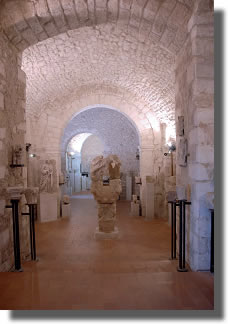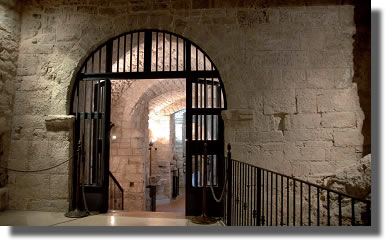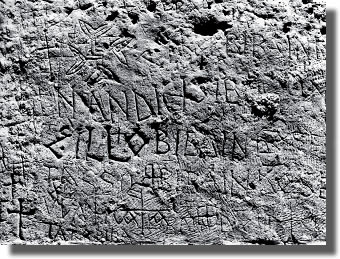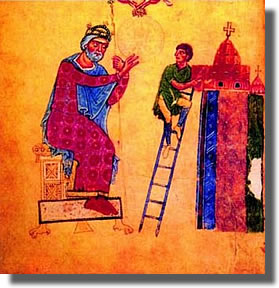Scientific Area » Longobard Culture » Pilgrimage
« Back
PILGRIMAGE
Pilgrimage, considered as a journey of an individual or a group to a sacred place is a kind of cult and devotion now intensely used which was very popular in such ancient (mainly universalistic) religions as Judaism, Induism, Buddhism, Christianity and Islam.
 |
 |
| Monte Sant’Angelo.Longobard tunnel | Monte Sant’Angelo. Façade of Longobard gallery |
In the Early Middle Ages, before the affirmation of the pilgrimage to Santiago de Compostela, the Roman shrines as well as that of St. Michael in Monte Sant’Angelo were the favourite destinations of pilgrims of Germanic origin. Paul the Deacon and Bede wrote that between 7th and 8th century many pilgrims, men and women, people of all ranks, lay and clerical, started from England to Rome, where they were given hospitality in the papal “xenodochia” or at a number of hostels founded by the Anglo-Saxons near St. Peter.

Pilgrims’ names engraved by a local lapicides in the Sanctuary of Monte Sant’Angelo
It is sure that many of these pilgrims went on with their pilgrimage to the shrine of St. Michael in Gargano which became a very important stage of the Itinerary to the Holy Land, as proved by the almost two hundred epigraphs discovered in the shrine which reveal different layers of Germanic and, above all, Longobard anthroponymy. These inscriptions hand down the memory of 182 people (178 men and 14 women), who almost all were of Longobard origin and could not write as many other pilgrims.
Their name was therefore written on the walls against payment of a remuneration by lapicides (hupographeis) stationed in the shrine. Clear names included anthroponyms of Semitic, Greek, Latin origin and at least ninetyseven of Germanic origin. These latter were in particular Gothic, Frankish, Saxon, Alemannic and Longobard (e.g. Afridus, Ansipertus, Arechis, Auderada, Cunualdus, Ildirissi, Isitrude, Luduald, Mauruald, Ratemund, Rodigini, Rumildi, Tato, Varnetrude, including some written next to acclamation vivas in Deo).

Arechi II and the construction of St. Sophia in Benevento
Such a variety of names emphasized how internationalized was the pilgrimage to Gargano between 7th and 9th centuries, becoming an experience of European significance which coincided with the period of maximum expansion and most incisive presence of the Longobards in Apulia, where the Dukes of Benevento, in 8th century, established the gastaldati of Siponto (740), Canosa (747) and Lucera (774).
In the Middle Ages, the pilgrimage to Gargano was a major factor of the “brownian motion” (as said Marc Bloch), that unceasing but at the same time “inconstant and perpetual” movement of individuals and groups, men and women, adults and children which concerned and spread throughout northern Europe, the Germanic and Byzantine civilizations.
But the pilgrimage was a permanent and long-lasting element in the changeable landscape of history with very strong (even ritual) repetitiveness and reproduction elements in a number of social environmental contexts above all in Europe, which can be referred to as an aggregate of pilgrimage destinations and shrines. Two aspects which, at different levels, made Europe unitary throughout the Middle Ages to the point that Goethe wrote: «The conscience of Europe was born wandering between Latin, Germanic, Celtic, Anglo-Saxon and Slav hubs ».
« Back


